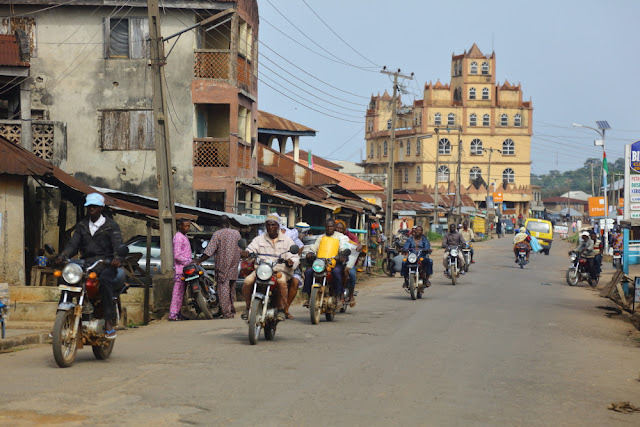 |
| running up the hill |
Iragbiji is a small but lively town, in Osun state, surrounded by hills made of curvy rocks emerging from the plain and partly patched with green. It is part of Yorubaland, about sixty kilometres East of
Osogbo. The heart of the town is the palace of the Oba (King of the area) next to a yellow multi-storeyed central mosque. The Oba is a muslim.
 |
| the Oba of Iragbiji |
Chief Muraina Oyelami, a versatile artist born in 1940, is residing in Iragbiji. He is both a talented talking-drum player and a painter. He welcomed us in his house for a talk on Yoruba culture especially about the talking drums which evolved in shape overtime to the modern form of goat skin cylinder whose sound can be altered by squeezing the ropes that are tied along the circumference of the drum to produce tons and therefore allows to emulate the Yoruba language through rhythm and tonality.
 |
| three sets of Yoruba drums |
There are actually three types of drums each playing a specific role in the intricate design of percussions which constitute the backbone of Yoruba music. Other instruments are a modern addition and may somehow be perceived as superfluous. Percussion and voice are the essence of Yoruba music. Dance complements it to embody the expression of a particular message or theme.
Tradition is therefore expressed and remembered as a combination of those three elements.
The masquerade, where a Egungun (ancestor spirit) is dancing to the tune of the drums or rather conversing with the drums is one example of it.
 |
| the Egungun interacting with the talking-drum player |
The Oba gave us an audience the next day. He was wearing a beaded crown. Probably in his fifties, he welcomed us and talked about the ambiguous relationship with Westerners and acknowledged that it was important for Westerners to understand what life was like in Iragbiji, among other places in Yorubaland, and not fall into the trap of the usual cliches that Westerners, who never travelled, would normally have about Nigeria.
His twenty four wives (if I recall well) danced and sung for us to the sound of the drums. A lady was in charge of singing the praise of the Oba.
 |
| Chief Muraina Oyelami |
We explored the hill overlooking the city which hosts a shrine at its top (a rather small and rusted enclosure encompassing a bush). A lovely walk with 360 degree perspective.
 |
| Iragbiji's main street |






Comments
Post a Comment